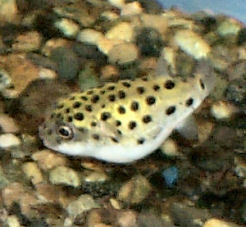Green Spotted Puffer Fish
Scientific Name: Tetraodon nigroviridis. (Sometimes confused with the Tetraodon fluviatilis.
Family: Tetraodon.
Home: Asia. Sri Lanka to Indonesia and north to China; they inhabit freshwater to brackish coastal estuaries like streams, rivers, and floodplains where they are found singly or in small groups.
Adult Size: 6 inches.
Diet: Crustaceans - mollusks and invertebrates in the wild. Foods for smaller puffers are frozen/freeze-dried krill/plankton, ghost shrimp, glass worms, crickets, worms and small snails (very small, the size of their eye). Snails are essential food to a puffer’s diet, especially when small.
Water Temperature: Tropical, 78-82-degrees Fahrenheit (25-28-degrees Celsius).
Water Chemistry: PH: 7.5 to 8.5, medium to medium hard water okay.
Background and Description:
Green Spotted Pufferfish is a fresh water tropical variety of the pufferfish family found in brackish (marine) water. The expert aquarists suggest that only advanced aquarist/hobbyists have Green Spotted Puffer.
The color is variable depending on age and the origin of the fish. In mature specimens the top and head area is marked with large Brown or Black spots. The spots on the side are smaller and also round in shape. The body color between spots is a beautiful Emerald Green color which makes a nice contrast to the dark spots. The bright green color is subdued in younger specimens. The fins are semi-transparent with a slight yellow tint.
The most recognizable trait of the Puffer is its’ ability to inflate a sac area of the gut or air to inflate themselves into the shape of a ball. However, the fresh water species does not appear to do this. While the “experts” claim that they should be kept only by “advanced” aquarists, most of those who breed and keep these fresh water variety find that the family of Puffers are not “demanding” in their care.
Many of the brackish or seawater (marine) variety can be acclimated to fresh water, even hard and alkaline.
The Green puffer becomes attached to its owner and becomes friendlier as it gets used to its new surrounding after you have introduced him in your tank. Eventually, the Puffer will get excited as you approach its tank.
The tank setup should contain plants and rock/structure, as well as open areas for swimming. Most aquarists suggest that the Puffer be kept alone or with other fish the same size.
The Puffer is an egg layer and lays their eggs on rock surfaces. The male will protect the brood and use his body to cover the eggs. The eggs hatch in about a week and the male will transfer the tadpole like fry to shallow pits and continue to guard them. The fry can be hard to raise and feeding them can be difficult, you should try a variety of small food including brine shrimp and observe which type they are eating. The mortality rate on the spawn is usually high.
Puffers will chase each other around the tank, and despite the claim of some aquarists - they are not aggressive, at least the fresh water variety called the Green Spotted Pufferfish. Aquarists have reported they have had guppies in the same tank with no problems. One aquarist wrote that they will eat fresh clam and oyster purchased at the local grocery market. Of course, you cannot put ghost shrimp in the same tank because they are part of their diet.
Their teeth are constantly growing, much like rodent mammals and providing rocks or coral for chewing on will prevent the teeth from overgrowing, unless you want to take the time to file them down. If their teeth get to long they will not be able to eat.
While they can be kept in fresh water, they live longer in brackish water. You can either introduce marine salt with a sg of about 1.005 and 1.010 or use the type of salt recommended for fresh water fish to keep them balanced.
Puffers are sensitive to water conditions and need to be introduced correctly to an aquarium - be sure to use the rule of at least thirty minutes in the bag you purchased them floating in your tank to ensure that the water temperature equalizes. The water temperature mentioned above should be maintained in that range. It prevents stress and disease that may kill or stunt their growth.
Puffers live in aquariums for 10 or more years. They grow to about 6-3/4-inches long. They are classified as omnivores.
It is recommended that a 20-gallon tank as a minimum with a well-planted 50 gallon tank being recommended.
Puffers like to swim at the bottom and middle areas of your aquarium.
Results 1 to 1 of 1
Thread: Green Spotted Puffer Fish
-
18-04-2009, 05:50 AM #1
Green Spotted Puffer Fish
Last edited by dirtydog; 18-04-2009 at 06:24 AM.
Thread Information
Users Browsing this Thread
There are currently 1 users browsing this thread. (0 members and 1 guests)











 Reply With Quote
Reply With Quote